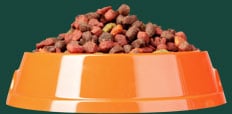"In 2001 a very special little kitten came to stay at our house named Emma. She weighed in at a whopping 2 ½ pounds. When she was about 9 months old she began vomiting and wouldn’t eat. The doctors at Piney Creek Square Veterinary Clinic took x-rays, but nothing showed up on them. She was losing weight, and she was thin by nature anyway, so everyone was worried about her. Dr. Behrns came to the rescue and performed emergency surgery on our little girl. She found an almond trying to pass into Emma’s stomach. Of course, it would not have shown up on an x-ray. Thank you, Dr. Behrns, for saving Emma’s life."
-Margo K.
The hard truth about obesity in our pets is that there are not many medical conditions that independently cause too much weight gain.
As owners, we are responsible so many more times than not. It is important that the INPUT of energy (i.e. food, treats) is equal to the OUTPUT of energy (i.e. exercise). When that balance is not maintained, your pet is at increased risk for so many diseases including diabetes, joint disease, liver disease and inflammation of the pancreas, to name a few.
Just like people, dogs and cats can have different resting metabolic rates. For example, how many of us have a friend or family member, trying to lose weight but can’t lose one pound when all they have is a salad and water. And another person, living at an ideal weight, can have the cheeseburger, fries and a milkshake and not gain a pound!
It is for your pet’s best interest to be conscious of how many calories your pet is ingesting on a daily basis and how that relates to your pet’s personal metabolic rate. At Piney Creek Square Integrative Veterinary Medicine, we can help you discern where your cat or dog falls on the scale of body condition scoring and calculate the amount of calories your pet should receive daily.
Please use the websites below to help you with these calculations as well.
Seasonal Tips & More
Our Professionals
Make An Appointment
Request a Refill
PINEY CREEK SQUARE
INTEGRATIVE VETERINARY MEDICINE
15420 E Orchard Rd
Centennial, CO 80016
HOURS
Monday through Friday from 8:00 a.m. – 6:00 p.m.
Closed from Noon to 1:30 p.m. for lunch
Closed Saturday’s, Sunday’s and major holidays.
© 2022 PINEY CREEK SQUARE INTEGRATIVE VETERINARY MEDICINE
While we often refer to clients to these resources, their inclusion on Piney Creek Square Integrative Veterinary Medicine’s site does not constitute an endorsement unless otherwise stated. Piney Creek Square Integrative Veterinary Medicine is not responsible for any outdated or incorrect information or links from these sites.

Website by Mad Cow Web Design